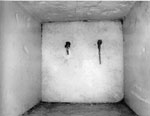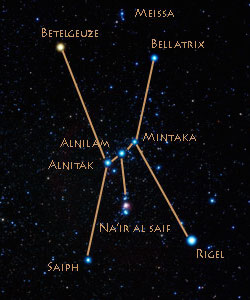One of the most mysterious features of the Great Pyramid of Giza are the so called “air shafts”.

It has been suggested that the shafts were used to ventilate the monument during construction. This would certainly be a problem, but the shafts do not run all the way to the outside and so it seems unlikely that they were intended to fulfill this function. No shafts were discovered in other pyramids, so the ancient builders must have found another way of overcoming this problem. The discovery of small finely finished limestone “doors” at the top of the shafts suggests that there was more to the shafts than ventilation. So what was the true purpose of these shafts?
Religious Symbolism
Stadelmann suggested that the shafts allowed the king’s soul to travel to the “stars that never die” (the circumpolar stars in the northern sky) and the “land of light” (the southern sky). This argument has a certain simplicity, and seems quite reasonable. However, it does raise some questions. Why does no other pyramid feature these shafts? Symbolic doors were a common feature in pyramids and tombs, so why did the builders decide that in this case the king’s soul would need a physical shaft to travel to the stars?
Secret Doors
At the top of the southern shaft of the Queen’s Chamber, a small limestone block with two copper fittings was discovered. Hawass has suggested that the fittings were hieroglyphic signs (rather than handles) which enabled the soul of the king to pass through the blockage.
When an opening was drilled through this small limestone block and an endoscopic camera inserted, archaeologists discovered a narrow empty space terminated by a rough limestone block, thought to be part of the pyramid core.

The shaft in the north side of the Queen’s Chamber is the same. The corridor ends in front of a white limestone block bearing the traces of two copper fittings. Quarry marks are still visible, along with the sign of the work-gang “wadi” (“the green ones”). and a sign thought to be the hieroglyph “prjj” (“to come out” of the tomb).
In 2010 Professor Richardson of Leeds University started work on a robot designed to investigate the shafts without causing damage to the pyramid. They managed to get a camera past the stone blocking the shaft and discovered a small chamber with intricate symbols painted on the floor. Beyond that, there was another stone blocking the shaft. The footage of the robot in the air shaft has now been released along with a documentary charting the discovery.
Star Alignment
Their astronomical significance was first proposed by Alexander Badawy, and Virginia Trimble, in the 1960s. They suggested that the north shaft of the Queen’s Chamber aligned with “Beta” (B) in Ursa Minor, while the south shaft is aligned with Sirius.
The constellation of Ursa Minor was only introduced in 600 BC. The Ancient Egyptians considered Ursa Major and Minor to be part of Draco (known to the ancient Egyptians as the Hippo). Draco was associated with the goddess Tawret (who took the form of a hippo). Sirius was associated with Isis and known as the “Nile Star” because of its annual appearance at sunrise on the day of the summer solstice which heralded the inundation.


The southern shaft in the King’s Chamber reaches to the outer surface of the Pyramid and is thought to be aligned with Orion’s belt. Orion was associated with Osiris, and was also the god of the netherworld. The northern shaft aligns with Thuban, in the constellation of Draco. Nowadays, Polaris marks our celestial north pole, but at the time of the ancient pyramid builders the star closest to the pole was Thuban. Thus, it was of high astrological importance and considered to be a symbol of immortality (as it never left the night sky).
Badawy and Trimble concluded that the shafts were not astronomical sight lines, as is sometimes suggested (a view supported by the fact that the shafts are horizontal at their ends and that they are blocked off). Instead they agreed that the shafts allowed the king’s soul to reunite with the stars. This is in keeping with writings in the fifth dynasty pyramid texts which confirm that the king joins circumpolar stars which never rise or set. They turn around the north celestial pole without ever dipping below the horizon. The ancient Egyptians called them the “undying” stars and took comfort from their stability and endurance.
Stellar Clock
The stellar alignment is not exact – and the Egyptians are often praised for their attention to detail. This has led some commentators (such as Buvall) to suggest that the alignment of the south shaft of the King’s Chamber to Orion and the south Queen’s Chamber to Sirius actually occurred much earlier than the Fourth Dynasty (2575 – 2465 BC), when the Great Pyramid is generally thought to have been built. Hence the argument that the pyramid is much older than previously thought, and that the shafts confirm the actual date of its construction.
Proponents of this view often suggest that there was an astrophysically advanced ancient culture which built the great pyramid and then disappeared, along with its advanced ideas. This is not a new idea. Plato (428 to 347 BC) refers to an ancient culture whose knowledge was lost in “Timaeus”, and Atlantis is still a remarkably popular idea.
Star Map
Robert Bauval (an engineer) and Adrian Gilbert also proposed that the three pyramids of Giza are an earthly representation of the Belt of Orion. They further suggest that the Fourth Dynasty “Unfinished Pyramid” at Zawyet el-Ayran, south of Giza, represents Bellatrix, and the pyramid of Djedefre at Abu Rawash, north of Giza represents Saiph. They suggest that the pyramids were intended to create an earthly copy of the stellar netherworld. Thus, the Great Pyramid of Giza becomes a time clock using the precession of the circumpolar stars to mark the dates of 10,500 B.C (when they suggest the plan was begun) and 2450 B.C (when they suggest the great pyramid was completed). So far no pyramids have been found which would represent Betelgeuse and Rigel, despite the fact that they are the two brightest stars in that area of the heavens.


This theory remains contentious. Ed Krupp (Griffith Observatory in Los Angeles) and Anthony Fairall (astronomy professor at the University of Cape Town) have both criticised the astronomical observations which underpin the theory and even suggested that in order to make the facts fit the map of the pyramids had to be inverted. However, Archie Roy (Professor Emeritus of Astronomy at Glasgow University) and Percy Seymour (astronomer and astrophysicist at Plymouth University) have defended the theory and noted that the visual correlation is striking when the pyramids of Giza are viewed from the north. Furthermore, there is some support for it in the fact that the Pyramid Texts (which date to the fifth dynasty but were most likely formed from earlier religious concepts) make frequent references to the connection between the resurrection of the king and Sahu (Orion).
Copyright J Hill 2010